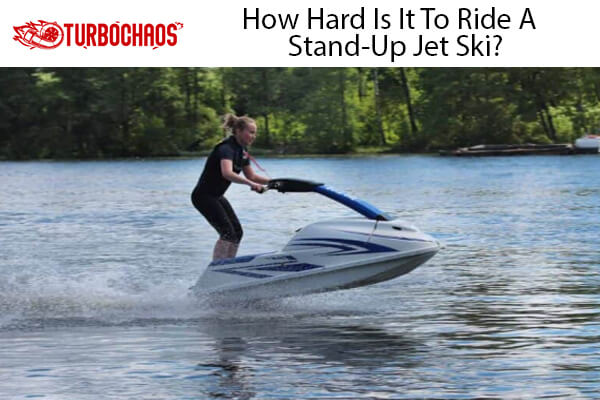How Hard Is It To Ride A Stand-Up Jet Ski? Expert Answer
Learning How Hard Is It To Ride A Stand-Up Jet Ski? Can be frightening. They take much more expertise than the typical sit-down model and are unlike any other type of watercraft. Learning to ride a stand-up jet ski can be challenging for some individuals, but it may be well worth the effort.
Many individuals who learn to operate stand-up watercraft never return to sit-down models. Some people are fortunate enough to succeed on their first attempt, but for those who might be having trouble, keep in mind these few pointers.
A stand-up model by Kawasaki, the Jet Ski, was the first successful consumer Jet Ski. (This is how the word “jet ski” for all personal watercraft is derived).
Currently, stand-up personal watercraft (PWC) are vastly outsold by sit-down variants, which can accommodate more passengers and offer greater space for relaxation.
However, a stand-up type is still the only option for many riders. If stand-ups are on your radar as a potential personal watercraft purchase, you have a few decent options. It depends on how fast you want to go and what you plan to do with the craft.
How Hard Is It To Ride A Stand-Up Jet Ski?
To ride it successfully, you’ll need a variety of athletic abilities in addition to practice. Many claim that riding a stand-up jet ski is as difficult as riding a wakeboard or water ski slalom. This is because they all require similar body positions, a sound sense of balance, and certain skills, especially when starting from deep water.

Is It Hard To Ride A Stand-Up Jet Ski?
Stand-up jet skis (PWC) are undoubtedly more difficult to ride than sit-down PWC since they need considerable balance, which calls for a fair level of core strength. You cannot expect to ride on a stand-up if you have never done it.
To stay on the Jet Ski and maintain balance, you’ll need to gain a feel for the type of movement and balance needed. Imagine it being similar to learning to ride a bike or a motorcycle for the first time.

Balance and mobility are the fundamental components. Like you cannot stand on a bicycle that is not moving, you cannot do the same on a stand-up PWC.
Instead, you must move the watercraft forward and change positions on it while kneeling or lying down before rising, just like you would when riding a surfboard to catch a wave. Along with core strength, some upper body and leg strength are also necessary for this.
Starting On A Stand-Up Jet Ski
First, it’s critical to comprehend the proper starting procedure for a stand-up jet ski. The most challenging aspect for beginners to master is possibly this. Once people are aware of how to begin, the rest comes naturally.
Shallow Water Start
Shallow water is the most typical place to start. While waist-high water usually works best, there is no hard and fast rule. Riders should ensure the emergency cut-off is securely attached to their PFD before continuing. They can move into position and begin once they know it is safely in place.
Put one knee on the Jet Ski’s deck while holding the handlebars. Typically, people prefer to kneel on the deck with their non-dominant foot while standing with their dominant foot in the water. In the end, whatever is most comfortable should be chosen.
Making sure that nothing is in front of the jet is crucial in this situation. When they first start, some beginners stand in front of the jet, which is risky and can result in injury.
Start the motor and slowly advance while kneeling on the boat with one leg remaining in the water. The watercraft will develop buoyancy and be much easier to level as it gains speed.
Pull the stronger leg out of the water and onto the Jet Ski while moving forward. This should be the lead leg placed at the tray’s front under ideal circumstances. Stand up aboard the boat after shifting your weight to the lead leg.
Each person has a different preferred foot position while cycling. Beginners are typically advised to spread their feet out diagonally on the tray. Their lead foot should be in the top corner, and their other foot should be on the opposite side in the bottom corner.
Begin In Deep Water
A deep water start is defined as anything higher than waist height. Starting in deep water can be done in one of two ways. At the very least, anyone learning to operate a stand-up jet ski should understand both of these.
The rider can rest their knees on the rear of the deck by first pushing the Jet Ski tray into the water. At this point, the boat may already be going in some cases, but if not, start it now.
Riders can then advance their lead foot and stand up as the Jet Ski picks up speed and momentum, changing their stance as they go. The shallow water start is similar, but both knees are already on the deck.
Body dragging is another method individuals use to start a stand-up jet ski in deep water. As the name suggests, riders put their forearms on the tray while clutching the handlebars, and as they take off, their bodies float through the water.
They make a push-up-like motion as they pick up speed, slide their knees under their bodies, and land on the tray. They slowly rise after that, shifting their feet as they go.
Make sure to avoid the jet’s path when using this strategy. Always be cautious of where the jet is positioned because this is a regular issue with this technique.
How To Turn On A Stand-Up Jet Ski?
Unbelievably, doing a stand-up Jet Ski turn takes more practice than most people imagine. It’s simple to master with a little amount of practice.
Begin by making gradual turns at a medium pace. This makes users feel at ease and understand how a stand-up jet ski handles. Riders should always accelerate more quickly while leaning into the curve.

Beginners frequently make mistakes here and fall into the water. The two most frequent errors people make when turning on a stand-up jet ski are failing to lean inappropriately or simply not accelerating.
Some individuals find it simpler to adjust their footing by the turn they are making. For left turns, the left foot should typically be the lead foot, and for right turns, the right foot should typically be the lead foot. Some people might find it too difficult to move their feet around. Instead of moving around, they opt to remain rooted in place, regardless of the turn.
Typical Rookie Errors On A Stand-Up Jet Ski
Many beginners make several common mistakes when first learning to ride a stand-up jet ski. However, I’ll list a handful of the most common pitfalls below.
Excessive Gas Pedal
Stand-up Jet Ski newbies often use excessive throttle when first getting going. There is a high chance of gasping the throttle if people don’t realize its sensitivity.
Lack Of Throttle
After getting going, novices occasionally struggle to master the turn on a stand-up jet ski. This is because they have to speed up while turning, which goes against common sense. Remember that a jet ski gets its propulsion from the water that shoots from the back. Inertia quickly overtakes the Jet Ski if there is no acceleration.
Poor Foot Placement
Beginners frequently have unnatural foot positions when learning to ride a stand-up jet ski. They have an abnormally narrow stance, or their feet are too close together. Either way, you risk losing your footing and tumbling into the pool.
Not Leaning Enough
A common mistake rookie riders make is underestimating how much tilting is necessary when cornering. This becomes second nature as experience is gained, but it might be challenging for many riders at first. The only way to address this issue is to find the optimal tilting level through trial and error.
Conclusion
Even experienced riders have been known to crash when using a stand-up jet ski. Even though learning is not simple, don’t give up. The best method to learn How Hard Is It To Ride A Stand-Up Jet Ski? Is by following these instructions. You will become a pro, a teacher, and a performer if you continue to practice.
Frequently Asked Questions
Is sitting or standing preferable for jet skiing?
The sit-down variant offers a comfortable ride with more options for spacing and lower dangers if you want to enjoy a smooth journey with family or friends. On the other hand, the stand-up Jet Ski may let you accomplish all tricks conceivable if you are only in it for some fun and a lot of adrenaline.
Do stand-up jet skis sink?
Jet skis can sink, but not completely, because flotation foam is integrated into the hulls of these vehicles. Therefore, the bow will float even if the Jet Ski fills with water. Your jet ski, however, could sustain various damages if a sizable volume of water leaked through the hull.
Is it challenging to steer a jet ski?
For some people, riding a jet ski can be simple, but for others, it might take some time and practice to feel at ease with the controls and handling. People with experience driving small boats or other personal watercraft typically find it easier.
Does a stand-up jet ski accommodate two riders?
As you know, one to four persons can safely and legally ride a jet ski. Since stand-up jet skis can only be operated by one person, this sport is best done alone. The smaller Rec-Lite watercraft might occasionally be challenging since although the 3-seaters are acceptable for 2 riders, the 2-seaters are fine for just 1.

Welcome to the exhilarating world of Matt Rex, a professional car racer turned renowned vehicle enthusiast. Immerse yourself in his captivating blog as he shares heart-pounding adventures, expert reviews, and valuable insights on cars, trucks, jets, and more. Fuel your passion for speed and discover the beauty of vehicles through Matt’s engaging stories and meticulous expertise. Join the ever-growing community of enthusiasts who find inspiration and expert advice in Matt Rex’s blog—a digital hub where the thrill of speed meets the pursuit of knowledge.





![Who Makes Power More Engines? [Answered]](https://www.turbochaos.com/wp-content/uploads/2023/11/Who-Makes-Power-More-Engines-768x521.jpg)

